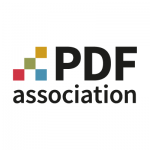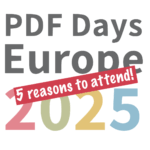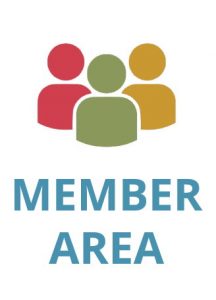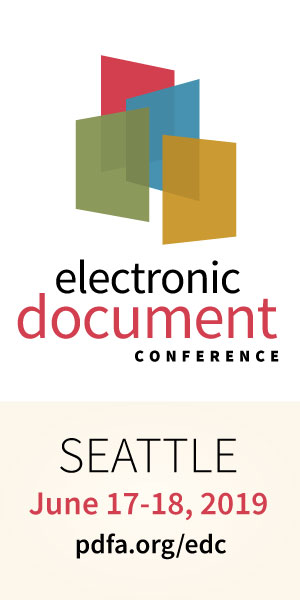Electronic Document Conference Agenda

The PDF Association staff delivers a vendor-neutral platform in service of PDF’s stakeholders.


The Electronic Document Conference is a do-not-miss event for developers, product managers and technical users creating and leveraging electronic document technology.
Learn more!
Meet the educational session speakers!
Check out the sponsored seminars!
Convince your boss to let you go!
Register now!
Learn more!
Meet the educational session speakers!
Check out the sponsored seminars!
Convince your boss to let you go!
Register now!
Program
All educational sessions are reviewed by a Program Committee; they're not “pitches”. There are no booths and no trade-show.
Sessions are 30 minutes each, including time for questions. Each block of sessions is closed with some words from one of the sponsors without whom this event would be impossible.
About the presenters
Presentations at the Electronic Document Conference are delivered by experts in the technology, product development or business of electronic documents. Follow the links in the program to learn more about them and their organizations.
Networking
In addition to the sessions during the conference day, EDC attendees and speakers are invited to a three-hour dinner cruise on Seattle's Lake Washington immediately after the panel on June 17. Cruise tickets are limited, and must be purchased when registering.
Sponsored sessions
Each block of conference sessions is followed by a single short (<5 minutes) commercial presentation offered by one of our sponsors. Gold sponsors will offer a 15 minute presentation during the event.
Location and facilities
Our Gold sponsor Adobe has generously donated space for the Electronic Document Conference at its lakeside facility in downtown Seattle.
Lunch and coffee-breaks will be provided throughout both conference days. Attendees should indicate any dietary or accessibility needs when registering.
Space is limited - only 200 spaces are available - so register today!
Monday, June 17 2019
0900 PT
KEYNOTE: Publishing Documents Precisely

David Blatner, President, CreativePro Network
09:40 Coffee break
11:50 Lunch
14:50 Coffee break
| 15:05 | 10 minutes with callas software | |
| 15:20 | Structured data and PDF - an all-conference discussion: From tagged PDF to XMP metadata and associated files, there are many ways to include data in PDF. While acknowledging PDF's reputation as the "place where data goes to die", this open discussion will focus on using PDF's mechanisms to store, exchange and leverage machine readable data. | |
| 16:45 | 10 minutes with iText | |
| 17:00 | Panel discussion: Challenges facing electronic document developers over the next 10 years | |
18:00 Dinner on Lake Washington
(additional cost - purchase ticket when registering for the event!)
Tuesday, June 18 2019
0900 PT
KEYNOTE: Boeing’s Digital Transformation Journey

Kenny Swope, Senior Manager & IPT Leader, 2nd Century Enterprise Systems Business Architecture
09:40 Coffee break
11:50 Lunch
| TRACK A | TRACK B | |
|---|---|---|
| 12:40 | Accessible math in PDF | Email archival in PDF - how does that make sense? |
| 13:15 | Impact of ECG on PDF publication | Document adaptation: responsiveness and personalization of the document experience |
| 13:50 | PDF’s ISO-standardized subsets - a tour | Blockchain for documents - the future of security |
| 14:20 | 5 minutes with callas software | 5 minutes with iText |
14:25 Coffee break
| 14:40 | Could PDF be a weapon in cyber warfare? | How reusable content in pdf could be: deriving HTML from PDF |
| 15:15 | 10 minutes with PDFTron | |
| 15:25 | The Mueller Report PDF: a content management #fail for the history books | |
| 15:40 | Privacy, GDPR and document technology, an all-conference discussion: A panel will lead discussion around technical strategies for managing content in the context of modern requirements for information protection. Bring your questions! | |
| 16:20 | 10 minutes with Computing System Innovations | |
| 16:30 | Panel discussion: "Ask a PDF expert" - questions for the panelists | |
17:00 END OF THE EVENT
Session descriptions
Structurally complex content in accessible PDF: How to represent mathematical formulas

The goal of PDF accessibility as defined in PDF/UA is to provide everyone with equal quality access to content in a PDF document, regardless of type of content. This can turn into a major challenge for structurally complex content, for example mathematical formulas. There have been very few, if any, solutions, and in addition there is no widely accepted single, correct way for accessible representation of formulas in PDF documents. At least for more complex formulas, offering an alternate description has to be considered insufficient. Depending on the target audience, there may be other and more satisfying approaches – but which of these is the right one for which target group?
An accessibility label for electronic documents
 Robert Martinengo, Consumer Accessibility Information Label Association (CAILA)
Robert Martinengo, Consumer Accessibility Information Label Association (CAILA)
The new Accessibility Information Label for electronic documents gives anyone who distributes electronic documents a simple and free method to demonstrate support for people with disabilities by disclosing accessibility information through a standard electronic label.
WCAG 2.1 Stratification to support gamification of accessibility training by role
 Sheri Byrne-Haber, VMware
Sheri Byrne-Haber, VMware
WCAG 2.1 Level AA is the de-facto standard for whether or not a digital property including a PDF file is accessible. But to someone without significant disability-related experience, memorizing the 50 guidelines can be a bit like the 5th grade exercise where students have to memorize the capitals of the 50 states in the US – it stays in your brain long enough to pass the test, and then it is immediately forgotten.
Sheri will present and review a common-sense, unique 10-category grouping of WCAG 2.1 Level AA guidelines as they pertain to PDF files to improve training opportunities and knowledge retention.
The sweet spot between automation and human remediation
 Peter Shikli, Access2online
Peter Shikli, Access2online
Rather than replace the accessibility analyst with software tools, this presentation looks at the best way to empower the analyst with software tools and other forms of automation. We begin with a review of the assessment and validation tools, where they are effective and where an experienced analyst needs to take over to make decisions. We present the use of structured and objective test criteria, and the use of remediation tools to improve quality and reduce cost, and the format of a deliverable that remediates and educates.
Accessibility, automation and AI: The future of accessible PDF documents
Anyone with PDF accessibility experience knows it can be technical and can get complicated quickly. Every day, organizations are looking for better, faster, and easier solutions to solve the problem including looking at automation. Sure, an automated solution that fixes everything would be great – but is that really possible? In this session we’ll discuss what in PDF accessibility can and can’t be done through automation. We’ll briefly address testing and creating accessible PDFs and explore revolutionary breakthroughs in remediation including the use of Artificial Intelligence.
Millions of PDFs once a month: serverless eStatements
 Jason Harrop, Native Documents
Jason Harrop, Native Documents
Scaling to deliver large volumes used to take a lot of effort, but with the advent of "serverless" offerings from cloud providers such as AWS (Lambda) and Microsoft (Azure Functions), it is now very easy to scale to hundreds or thousands of instances - provided your PDF application is serverless-ready. Here we look at what it takes to go serverless - from vendor and customer perspectives - our use case being eStatement production in the banking, telecom and utilities sectors, which for many companies involves millions of PDFs once a month.
Where Does PDF fit in the future of documents?
Many people know the PDF file format for its fidelity in printing and presenting documents. PDF feels so ubiquitous with digital documents now that running into fidelity issues today seems more like a bug than a feature. However, there's much more being done today with digital documents via the PDF file format that everyone is not aware of. What's next? What will be required of digital documents in the next 10 to 20 years? In this talk, we'll recap how digital documents are used today and dive into some possible use cases that may arise over the next decade or so. Finally, we'll discuss whether these can already or should be accomplished via the PDF file format.
Interoperable CCM to connect legacy, current and future platforms
Dynamic, fast-paced, matrixed, omnichannel, multi-directional communication between organizations and all stakeholders is the current goal of contemporary communicators as Customer Experience meets Digital Transformation meets intelligent documents. This proposal is about the role of the intelligent document in the communication strategy of one such organization. Because the solution is considered strategic by the organization, it is by necessity a masked case study.
Automatic distribution of full indexed documentation with multimedia content for large production plant guides
This paper discusses the importance of documentation limitations, and the problems they can create, identifies the role of PDF with packaged extra-contents as the best relying technology to quickly deliver, store and browse technical manuals in a heavy-duty environment. By describing a real-life case study, we would like to show how well-organized digital contents and proper software environment can improve the life of technicians in charge of plant maintenance.
The Mueller Report PDF: a content management #fail for the history books
 Duff Johnson, PDF Association
Duff Johnson, PDF Association
Perhaps the highest-profile PDF file of the century was released in April, 2019, and it wasn't a pretty sight. A 448 page document, this file tipped the scales at 140 MB. It had been redacted, printed and scanned before posting; maybe even scanned twice. It included no searchable text, no tags and no metadata. The scans were low quality; the redactions made effective OCR (and thus, text search) almost impossible. But it was still a PDF, even if the format was merely used as a way to collect 448 images into a single file.
The Mueller Report revealed some profound truths about documents, workflows and redaction, with implications for attorneys, courts, researchers, journalists, ECM practitioners and developers specializing in content reuse. Based on Duff's recent articles about the Mueller Report PDF, this brief session will briefly present the problems highlighted by the Mueller Report, and zero in on how modern businesses can reduce risks by ensuring that their workflows address documents as (re)usable information and avoid treating them as mere physical objects.
I didn’t know PDF could do that!
 Matt Kuznicki, PDF Association
Matt Kuznicki, PDF Association
PDF – the Portable Document Format – contains multitudes. Over more than a quarter-century as a publicly available and implementable standard, PDF has become a collection of features and functionalities for a variety of industries and users. Many users – even many PDF practitioners – only scratch the surface of what PDF can do. Here, we’ll learn about some of the more interesting features that are part of the PDF standard. Leave what you believe PDF can do at the door and come learn about how PDF is so much more!
Accelerated document rendering with modern hardware
 Michael Vrhel, PhD., Artifex Software
Michael Vrhel, PhD., Artifex Software
Today’s hardware provides several options to leverage in the rendering of documents. These include multi-cores, single instruction multiple data (SIMD) intrinsics, and general-purpose graphic processing units (GPGPUs). In this talk, we will explore the use of some of these methods for processing documents. In particular we will focus on multi-banded rendering and SIMD instructions for transparency, color conversion, interpolation and half-toning.
PDF vs Office: Is reliable Office rendering possible?
Anyone who has worked in-depth with the PDF format could be forgiven for thinking that it has parts that are a bit archaic or of questionable utility. We used to think so, until we started working with Office documents -- we now believe PDF is shining example of a well-designed and consistent file format. In this talk, we'll take an in depth look into the challenges inherent in translating from Office to PDF (and vice versa). Some of these challenges are fundamental -- Office files are reflowable, whereas PDF is not -- and some of them are about discovering how many implicit and competing unit systems can be fit into one file format.
Accessible math in PDF
We provide the detailed analysis of the current state of art of Math accessibility in PDF publications. It covers the complete document flow from the Authoring software to the Accessibility AT. In the center of this flow we have the new Tagged PDF 2.0 features. However, there is still a (very!) long way to pack mathematical formulas correctly into PDF and then to properly interpret them. We also give a demo of how this might work using LaTeX or InDesign as an authoring software and the derivation algorithm as an accessible way to interpret the resulting PDF.
Impact of ECG on PDF publication
 William Li, Kodak
William Li, Kodak
This talk will examine the implications of Extended Color Gamut (ECG) printing as a production method on requirements for the PDF files which lead to this type of work.
PDF’s ISO-standardized subsets - a tour
 Dietrich von Seggern, callas software
Dietrich von Seggern, callas software
PDF based standards such as PDF/A and PDF/X play an important role in various industries, and there are a few more. Why are there so many different standards? What are their “USPs" (differences)? Which of these standards have changed industries and what alternative formats exist? Is it possible to comply with all of them, and how?
Open data - PDF beyond final form visual content
Everyone knows that PDF excels as a format for presentation (viewing and printing) as well as archiving of final form textual and graphical content, but when it comes to being able to access “data” in or even referenced by such final form content, the pundits posit that “PDFs are where data goes to die!” In this presentation, we will demonstrate that with relatively little effort, PDF final form presentation and underlying data are very compatible. With some creativity and planning as well as with augmented features of PDF 2.0, PDF is where data thrives.
Leveraging vector graphics in PDF
 Jean Haney, Visual Integrity
Jean Haney, Visual Integrity
We’ll focus on working with the graphics in a PDF file, especially in the PowerPoint, Visio and AutoCAD contexts. We’ll discuss raster (scanned) and vector (application-generated) PDF files and focus on accessing the rich contents of a vector PDF file, using that information to generate files in other formats, as well as deleting, changing, replacing and extracting objects. This session is ideal for content managers who need to make PDF-based drawings available for editing as well as marketing groups who want to leverage vector-based house graphics in their organization’s collateral.
Why searching for content in 2019 still feels like 1919
This session examines the challenges of indexing and searching content in various document formats including, but not limited to, PDF and HTML. We’ll review the factors that limit today’s methods for understanding searched content and expressing the semantics of search results, and discuss and how we can improve on users’ experience in the future
Transform the supply chain with 3D PDF
Evolving business-to-business data exchange requires innovative methods to concisely and effectively share designs and information across a wide range of applications. Using 3D PDFs to combine engineering drawings with business intelligence is the natural step toward more efficient procurement operations.
The presentation will begin with the fundamentals of 3D PDF, answering: “What is a 3D PDF?” Using examples from a high-tech plastics engineering company, we’ll demonstrate how to take advantage of the multi-faceted feature set of 3D PDF to bring relevant PLM/BOM engineering, ERP business, and CAD design components to one page. Along with this example, the controls of a 3D PDF and how to review its contents will be shown. We'll outline options in generating 3D PDFs, finding resources, and planning first steps. Finally, we'll cover best practice in distribution choices for delivering completed 3D files to suppliers, as well as options for receiving and viewing these documents.
Are you confident that your redacted documents are safe to be shared?
Removal of sensitive information from public documents is increasingly important, particularly for privacy concerns. Redaction is a critical operation that requires multiple steps and the expertise to execute accurately. We’ll review the internal syntax of a document, looking at the changes to image data and content streams before and after a redaction has been applied. Learn how to ensure that your PDFs are fully redacted and appropriate for dissemination.
PDF documents, artificial intelligence, and robotic process automation
 Henry Sal, Computing System Innovations
Henry Sal, Computing System Innovations
Artificial intelligence software can automate PDF document workflows, review and validate PDF document contents, automate data entry and redact private information. This session discusses the latest in applications of artificial intelligence software to reduce costs in both extraction and redaction of PDF documents containing unstructured data and explores a case study based on the experiences of the Palm Beach Florida Clerk of the Courts office.
Email archival in PDF - how does that make sense?
 Dietrich von Seggern, callas software
Dietrich von Seggern, callas software
"What are the reasons to consider archiving email as PDF? What problems can be addressed? What opportunities can be created? What new problems arise? What are the fundamental advantages, capabilities and decisions an implementer should consider? This session offers some recommendations and considerations for best practice.”
Document adaptation: responsiveness and personalization of the document experience
As the nature of computing has changed, bringing screens from the size of watches to interactive walls, how do documents respond to this challenge? How do end users gain some control over this experience without losing what is important about the document?
Blockchain for documents- the future of security
 Ross Frank, iText
Ross Frank, iText
This talk reviews how the use of blockchain technology can benefit document workflows. Blockchain technology can be used to secure PDF invoices and digital signatures and makes it possible to store digital signatures in a blockchain itself instead of in the PDF document at all. This approach facilitates faster signing processes, confirms document security and provides real time tracking of signatures and version control.
How reusable content in pdf could be: deriving HTML from PDF
With good techniques and well-prepared PDF we can achieve and guarantee consistent results when processing PDF content for representation as HTML without compromising current page based document representation. We will describe an algorithm that reliably produces conforming HTML from well-tagged pdf files. The talk is aimed at developers and software architects who need to address interoperability issues with PDFs, reuse of content, structure extraction and data interexchange. I’ll provide samples of well-structured PDFs and derived HTML that could be responsive and serve as alternate representations.
Could PDF be a weapon in cyber warfare?
 Duff Johnson and Peter Wyatt, PDF Association
Duff Johnson and Peter Wyatt, PDF Association
Today PDF is the format of choice for every kind of document used in all industries, governments and by all citizens. It is trusted by everyone to reliably communicate accurate information... but how can we guarantee a document and its information is truly safe, trustworthy, and authentic? Verifying the trustworthiness and provenance of the barrage of PDFs received by an organization is an exceedingly difficult task as individuals and organizations routinely engage with data shared by unauthenticated and potentially compromised sources. Further, the software used to process documents is error-prone and vulnerable to exploitation through maliciously crafted data inputs, opening the technology and its underlying systems to compromise.
As we've mentioned previously, DARPA's SafeDocs program is researching new methods to impede an attacker’s ability to deliver novel cyberattacks via electronic documents, messages, and streaming data formats.


















